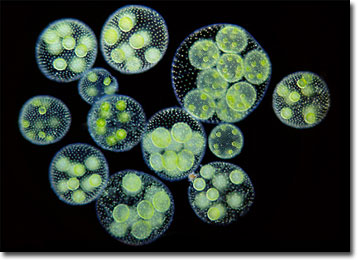Wim van Egmond
Volvox Colonies
Volvox is a genus of freshwater organisms that contain chlorophyll and live in colonies. The taxonomy of the creatures, however, is ambiguous, and they are sometimes considered part of the order Volvocida, a group of flagellate protozoa, while at other times they are categorized as members of the green algal division Chlorophyta

Individual cells of Volvox resemble the appearance of Chlamydomonas species. They are round or oval and exhibit a pair of flagella and a red eyespot, or stigma. The flagella of the organisms extend outside of the colony, which may contain as may as 50,000 individuals and can frequently be seen by the naked eye. The hollow, mucilaginous balls, which reach up to 1 millimeter in diameter, are often found spinning gracefully through the water of ponds, puddles, and ditches. In areas of high nitrogen content, Volvox blooms may occur, especially in the summer months. In fact, Volvox may be used as an indicator species, alerting ecologists of instances of nitrate enrichment.
Worldwide, about 20 species of Volvox have been described. As primary producers, the photosynthetic organisms are an important part of many aquatic ecosystems. For instance, as they convert the energy of the sun into organic molecules and nutrients, they produce dissolved oxygen, a substance needed in significant quantities by many life forms. Moreover, their position at the bottom of the food chain makes them a principle component of the dietary regimens of many aquatic organisms, such as rotifers. Volvox colonies are also important to humans and have undergone intensive investigation. Many scientists are particularly intrigued by the division of labor found among the cells in their colonies, believing that the organisms exist at an evolutionary crossroads, only a step away from true multicellularity.
BACK TO WIM VAN EGMOND GALLERY
